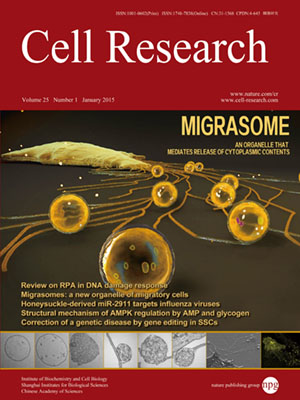
Volume 25, No 1, Jan 2015
ISSN: 1001-0602
EISSN: 1748-7838 2018
impact factor 17.848*
(Clarivate Analytics, 2019)
Volume 25 Issue 1, January 2015: 50-66 | Open Access
ORIGINAL ARTICLES
Structural basis of AMPK regulation by adenine nucleotides and glycogen
Xiaodan Li1,2,3,*, Lili Wang1,2,3,*, X Edward Zhou3,*, Jiyuan Ke3, Parker W de Waal3, Xin Gu3, M H Eileen Tan3,4, Dongye Wang1, Donghai Wu1, H Eric Xu3,5 and Karsten Melcher3
1Key Laboratory of Regenerative Biology, Guangzhou Institute of Biomedicine and Health, Chinese Academy of Sciences, Guangzhou, Guangdong 510530, China
2School of Life Science, University of Science and Technology of China, Hefei, Anhui 230027, China
3Laboratory of Structural Sciences, Van Andel Research Institute, 333 Bostwick Ave, NE, Grand Rapids, MI 49503, USA
4Department of Obstetrics & Gynecology, National University Hospital, Yong Loo Lin School of Medicine, National University of Singapore, 119074, Singapore
5VARI/SIMM Center, CAS-Key Laboratory of Receptor Research, Shanghai Institute of Materia Medica, Chinese Academy of Sciences, Shanghai 201203, China
Correspondence: Karsten Melcher,(karsten.melcher@vai.org)
AMP-activated protein kinase (AMPK) is a central cellular energy sensor and regulator of energy homeostasis, and a promising drug target for the treatment of diabetes, obesity, and cancer. Here we present low-resolution crystal structures of the human α1β2γ1 holo-AMPK complex bound to its allosteric modulators AMP and the glycogen-mimic cyclodextrin, both in the phosphorylated (4.05 Å) and non-phosphorylated (4.60 Å) state. In addition, we have solved a 2.95 Å structure of the human kinase domain (KD) bound to the adjacent autoinhibitory domain (AID) and have performed extensive biochemical and mutational studies. Together, these studies illustrate an underlying mechanism of allosteric AMPK modulation by AMP and glycogen, whose binding changes the equilibria between alternate AID (AMP) and carbohydrate-binding module (glycogen) interactions.
10.1038/cr.2014.150
FULL TEXT | PDF
Browse 2363


